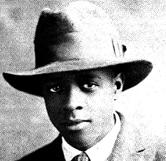
- Wallace Thurman
Thurman, Wallace (1902–1934), novelist, editor, poet, playwright, and literary critic. After leaving his native Salt Lake City, Utah, for the University of Southern California, Wallace Thurman established the Outlet, a magazine similar to those being published as part of the artistic renaissance then blossoming in Harlem, New York.
When it failed after just six months, he himself headed for Harlem, arriving in September 1925. The younger Thurman became a scathing critic of the bourgeois attitudes that motivated the Harlem Renaissance old guards like Alain Locke and W. E. B. Du Bois, charging that they professed their intellectual and artistic freedom while seeking white approval with slanted portrayals of African Americans.
Eventually, he was able to articulate clearly, if not achieve completely, the aesthetic principles of the Harlem Renaissance from the late 1920s to the 1930s. Thurman’s New Republic essay, “Negro Artists and the Negroâ€� (31 August 1927), decries the popular tendency to reduce African American music, fiction, poetry, and painting to the level of a fad presented in a “conventional manner about the ‘best people.’â€� He claimed that many of the artists receiving praise from white and black critics alike were more interested in sociology and propaganda than art and, with few exceptions such as Langston Hughes and Eric Walrond, refused to create forms best suited for candid African American expression.
Thurman published the experimental journal Fire!! (1926), which “was purely artistic in intent and conception,� to address this problem. Contributors such as Langston Hughes, Zora Neale Hurston, Arna Bontemps, and Thurman himself were mainly interested in depicting African Americans “who still retained some individual race qualities and who were not totally white American in every respect save skin color.� When the magazine folded after only one issue and left him with a thousand dollar debt (that took four years to discharge), he began the longer-running journal Harlem, A Forum of Negro Life (1928), which eventually suffered a similar financial fate. Undaunted, Thurman went on to write two novels.
The Blacker the Berry (1929) addresses a variety of controversial themes including homosexuality, intraracial prejudice, abortion, and ethnic conflict between African Americans and Caribbean Americans. The satiric Infants of the Spring (1932) is the only renaissance novel that evaluates the renaissance itself and the judgment rendered is harsh and unsparing. A third novel, The Interne (1932), written in collaboration with white Abraham L. Furman, is an exposé of unethical behavior at City Hospital on Welfare Island (now Roosevelt Island), where Thurman ultimately died. In his short life, Thurman was a prolific author whose works include published essays, screenplays, poetry, and short fiction.
While Thurman had an exceptional mind and was regarded as the spokesman for the younger generation of Harlem artists–especially by Langston Hughes who in The Big Sea (1940) marvels at his voracious reading ability–his bohemian behavior and personality tended to undermine his artistic ability. Many of his literary efforts failed not because they lacked merit but because they lacked funds, which he tended to dissipate in a decadent lifestyle imitative of literary counterparts from Greenwich Village. Even his greatest financial success, Harlem (1929), a play produced in collaboration with William Jourdan Rapp, editor of True Story magazine, left him in debt. Significantly, whenever Thurman became strapped for money, his high artistic standards quickly evaporated. For example, Thurman ghostwrote stories for the lowbrow True Story magazine under such pseudonyms as Ethel Belle Mandrake and Patrick Casey.
Thurman’s greatest literary shortcoming was his inability to sustain serious criticism of white America. Indeed, in an essay in the Independent (24 September 1927) magazine, Thurman goes so far as to claim that whites could probably write the African American story better than African Americans because the whites could be more objective about it. Thus, even while he sharply castigates African Americans for assimilating into the American mainstream to the point of losing their unique identity, he cannot imagine that the fear of dark skin traditionally exhibited by whites might also render them unobjective in their portrayal of African Americans. Essentially, then, Thurman’s works reflect the struggle during the Harlem Renaissance to articulate an African American aesthetic while coping with the self-hatred that always hinders this endeavor. So far there is no biography or full-length critical study of his literary.